A Tale of Two Cities and Great Expectations (Oprah's Book Club) (55 page)
Read A Tale of Two Cities and Great Expectations (Oprah's Book Club) Online
Authors: Charles Dickens

A Tale of Two Cities
Widely regarded as a subfield of philosophy until the mid-nineteenth century, psychology was first developed into an independent scientific discipline in Germany. The British psychologists (to employ a slight anachronism) of Dickens’s period were influenced by the ideas of John Locke about the self as a composite of experience, and particularly by his theory of association. Throughout the nineteenth century scientists attempted to discover a biological mechanism for the association of ideas. One early hypothesis, the pseudoscience of phrenology, first developed by Franz Gall and then popularized in Britain by George Combe, had widespread impact. Phrenology claimed that different areas, or “organs,” of the brain (which manifested in the shape of the skull and its varying protrusions) corresponded to character traits—spirituality, love, greed, language. The larger its organ in the brain, the more developed the trait in the person. Combe’s hypothesis was popular because it offered a simple, physical explanation for personality. Counterintuitively, however, another reason for the popularity of phrenology was its emphasis on self-formation. Mapping one’s head, and thereby identifying weak and strong faculties, it was believed, enabled one to exercise and further develop one’s deficient capacities, thus overcoming the limitations endowed by nature at birth.
Phrenology eventually was disputed by scientists, but both psycho-physiologists (as those who studied mind-brain phenomenon were known at the time) and popular writers of self-help manuals agreed about the power of beliefs, mental associations, and habits to shape a person’s character. In
A Tale of Two Cities
, Sydney Carton is a cynic about human nature and, though brilliant, dissolute and self-destructive. His last, heroic (yet utterly self-destructive) act is associated with his romantic feelings for Lucie Manette, which bring out his ideal nature. Dickens also creates a fascinating representation of psychology in Dr. Manette’s reaction to his long and solitary imprisonment, that is, the physical activity of shoe making, which is a solace to his fears of solitary confinement and also how he safely channels his anger. Alone after his daughter weds the nephew of the man who had Manette imprisoned, the doctor loses his ability to repress his associations between his new son-in-law and his former prison cell, and he slips into an almost catatonic state, just like the one in which Mr. Lorie finds him after his release from the Bastille. In this state of mind, Manette reverts to the activity that provided an outlet to him while in prison: he begins making shoes. In chapter 19, when Mr. Lorry questions his friend about the causes of the relapse, Dr. Manette suggests that it was sparked by a “strong and extraordinary revival of the train of thought and remembrance that was the first cause of the malady. Some intense associations of a most distressing nature were vividly recalled, I think.” The idea of destroying the bench and the tools causes Manette to feel “a sudden sense of terror, like that which one may fancy strikes to the heart of a lost child.” His poignant description highlights the feelings of vulnerability, as well, perhaps, as a repressed desire for revenge, that remains deeply embedded in his mind, even after his recovery.
Dickens championed theatrical entertainment as a positive contribution to the quality of life, especially for working people, who had to strive to merely survive. He referred to “an innate love . . . for dramatic entertainment” (“The Amusements of the People,”
Selected Journalism
499). As he explains in an essay for
Household Words
called “Lying Awake,” he believes the popular taste for the miraculous events of the theater is correlated to the precariousness of working people’s lives: “This particular public have inherently a great pleasure in the contemplation of physical difficulties overcome; mainly, as I take it, because the lives of a large majority of them are exceedingly monotonous and real, and further, are a struggle against continual difficulties, and further still, because anything in the form of accidental injury, or any kind of illness or disability is so very serious in their own sphere” (
Selected Journalism
28). (It is worth pointing out that this was an era before any type of social benefits or social safety networks, such as unemployment or disability insurance.)
Originally referring to a drama in which music alternated with the actors’ dialogue, melodrama was an enormously popular dramatic form in the nineteenth century, and also was incorporated into various kinds of sensational fiction. Dickens’s novels exhibit many of the miraculous events that characterize melodrama.
A Tale
of Two Cities
, for example, employs reversals of fortune, which occur when Charles Darnay returns to France in an effort to secure the release of his family estate’s caretaker, and then is imprisoned himself, but later freed through the intervention of Dr. Manette, who has become a revolutionary hero because of his years in the Bastille. In a dark turn of events, Darnay is re-arrested on the basis of new documentary evidence surfacing—another common melodramatic trope. Ernest Defarge produces in court Manette’s prison letter that will condemn Darnay. Dr. Manette also experiences a reversal when the Revolution, which first frees him from the Bastille, ironically then threatens to destroy his family. The set of narrow escapes by the English characters toward the end of the novel is another common trope of melodrama.
The stage adaptation of Dickens’s
A Tale of Two Cities
(adapted by Fox Cooper and produced by Tom Taylor) rewrites Dickens’s bittersweet ending. The play fully exploits the poetic justice so familiar to melodrama, but which the novel only invokes partially. In the stage version, after saving Darnay, Sydney Carton manages to switch clothes with Ernest Defarge, so that Defarge, not Carton, falls victim to the guillotine in place of Darnay. An illustration of the fight scene between Miss Pross and Therese Defarge depicts, as in the novel, the Frenchwoman with pistol in hand. When it discharges during the struggle to determine whether or not Lucie has fled, which Miss Pross desires to thwart, the revolutionary is killed by her own hand. With both the villains vanquished, the play heightens the melodramatic effect of good triumphing over evil, without requiring the sacrifice of Carton’s life.
“Those were drinking days, and most men drank hard,” the narrator remarks after the closing depiction in the previous chapter of Sydney Carton falling drunk asleep on his dinner table. Carton’s dissolute behavior contributes to the reader’s sense of his being irredeemable. Although Dickens claims that “Time” has “improved [men’s] habits” of alcohol consumption, many nineteenth-century social reformers disagreed. These reformers focused on alcohol as a major cause of the underclass in Britain. What became known as the Temperance Movement had roots in Evangelical religion and Utilitarian philosophy, both of which valued middle-class ideals such as thrift, self-improvement, and self-restraint. Temperance reformers disdained leisure and championed self-control, to which alcohol was seen as a detriment.
On the other hand, many working-class people viewed debates about alcohol use as diverting political attention from the real problems facing the poor—inadequate sanitation, overcrowded slums, as well as exploitative labor practices. Some working-class-affiliated reformers formed the “teetotalers” movement, which encouraged members to pledge total abstinence from alcohol. Yet they were a minority voice among the majority’s resistance to middle-class social control. Dickens certainly espoused the values of hard work and self-improvement, and his letters show some sympathy for the work of temperance reformers. However, Dickens never aligned himself with the teetotalers and temperance movements. He felt that working people needed outlets for leisure, including the “cheering” effects of moderate alcohol consumption. This makes his depiction of Carton all the more interesting. For in Sydney Dickens reveals a man whose self-destructiveness is fueled by heavy drinking.
There is certainly a parallel in the novel to the French revolutionaries, the Defarges, who are wine merchants, and the symbolism of wine and blood flowing simultaneously is suggestive of the danger that intoxication contributes to a rioting crowd’s heedless violence.
The nineteenth century could be called the century of the penitentiary. Reformers worked to end public physical punishments—from whippings to hangings; they objected to the spectacle of violence. When Dickens’s contemporary, William Makepeace Thackeray, wrote about his witnessing of a hanging, he expressed disgust for the picniclike air of the crowd. Likewise, there was much debate about the advantages or cruelty of sentences to penal servitude, that is, transportation to Australia (Magwich, Pip’s mysterious benefactor, in
Great Expectations
was a transported convict). By the Victorian period incarceration gradually replaced the more public forms of corporal punishment. The regime of English prisons emphasized hygiene, order, surveillance, and religious indoctrination. The silent system, in which prisoners worked together in mandatory silence, was supplanted by a system of solitary confinement, which some penal theorists believed prevented recidivism by keeping less violent prisoners away from more hardened criminals.
Many counties added police forces during the 1850s and ’60s, and as statistics began to be gathered in more scientific ways during the Victorian period, civil administrators discussed methods for the prevention of crime, especially youth crime, the evidence as to whether or not crime rates were falling, and to what was owed that social progress. The expansion of education, the police, and increasing employment opportunities all were believed to have contributed. As in current penal theory, controversial subjects included the causes of recidivism and the effectiveness of incarceration as a deterrence for criminal activity.
The prison is one of the dominant images of Dickens’s imaginative work. Dickens wrote several features explicitly about prisons that were published in
Household Words
. The best known, perhaps, is his strong condemnation of solitary confinement in chapter 7 of
American Notes for General Circulation
(1842), written after his travels to the United States. While traveling briefly through Philadelphia, Dickens visited public institutions there, including a hospital, a library, the Exchange and post office, and a prison. According to Dickens, the Eastern Penitentiary’s system is “rigid, strict, and hopeless solitary confinement.” Dickens believes the Eastern Penitentiary intends to be humane, but, he says, “I am persuaded that those who devised this system of Prison Discipline, and those benevolent gentlemen who carry it into execution, do not know what it is that they are doing.” Dickens imagines the tortures of solitary confinement:
I hold this slow and daily tampering with the mysteries of the brain, to be immeasurably worse than any torture of the body: and because its ghastly signs and tokens are not so palpable to the eye and sense of touch as scars upon the flesh; because its wounds are not upon the surface, and it exhorts few cries that human ears can hear; therefore I the more denounce it, as a secret punishment which slumbering humanity is not roused up to stay. [. . .] He sees the prison-officers, but with that exception he never looks upon a human countenance, or hears a human voice. He is a man buried alive; to be dug out in the slow round of years; and in the mean time dead to everything but torturing anxieties and horrible despair.
His description of the Philadelphia prison, excepting that he believes the prison officials to have “excellent motives,” is very like the man “buried alive” in
A Tale of Two Cities
, Dr. Manette. In another passage, Dickens imagines the stages of reaction to solitary imprisonment—from stunned, to despairing, to stupor. “Give me some work to do, or I shall go raving mad!” he supposes the prisoner exclaiming, when his grated door is opened.
The prison is evident thematically in many of his novels besides
A Tale of Two Cities
, most obviously the Marshalsea debtors prison of
Little Dorrit
, and the Newgate prison in
Barnaby Rudge
, which, like
A Tale of Two Cities
, depicts a crowd breaking it open. As critics such as A. O. J. Cockshut have discussed, the image of the prison and the felt experience of the prisoner are related to the determining force of other institutions represented in Dickens’s fiction—not only claustrophobic houses, such as Satis House in
Great Expectations
, but also the workhouses in
Oliver Twist
and Squeers’ boarding school in
Nicholas Nickleby
. The court of Chancery in
Bleak House
and the bureaucracy depicted in
Little Dorrit
are related representations of detention and restriction.
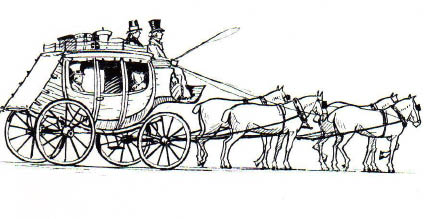
i1. Line art drawing of a coach, by Pearson Scott Foresman.
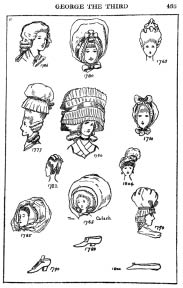
i2. These drawings of headdresses and shoes from the late eighteenth century suggest the type of large bonnet Miss Pross wore.
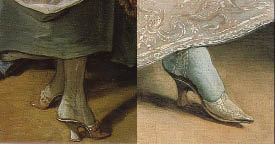
i3. Examples of mid-eighteenth-century women's mules, of the type Dr. Manette might have made while in the Bastille.
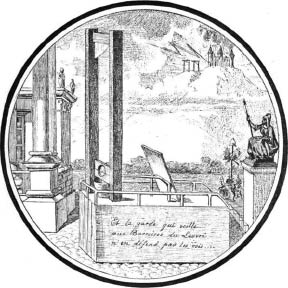
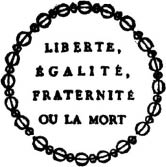
i4 and i5. A late eighteenth-century rendering of the guillotine, from Octave Uzanne,
Le Livre
(Paris: A. Quantin, 1885), and an example of the motto of the revolutionaries.
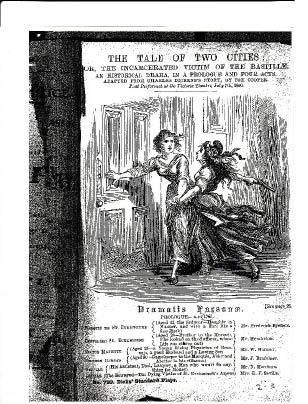
i6. A drawing from the Tom Taylor, Fox Cooper play copy of
A Tale of Two Cities
(London: J. Dicks, 1886), depicting the struggle between Miss Pross and Madame Defarge.
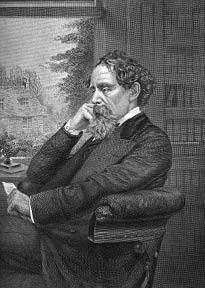
i7. Charles Dickens in his study at Gad's Hill Place, by Evert A. Duyckinck, from
A Portrait Gallery of Eminent Men and Women in Europe and America
(New York: Johnson, Wilson & Co., 1873).
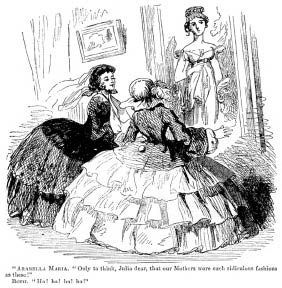
i8. This cartoon compares women's style of dress from the late eighteenth century with that of the mid-Victorian period in which Dickens wrote
A Tale of Two Cities
.
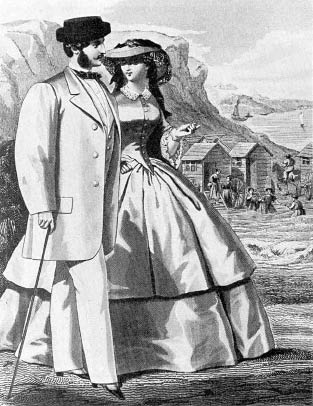
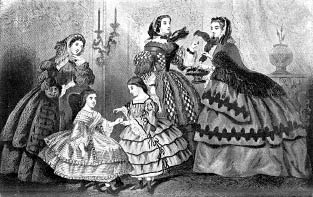
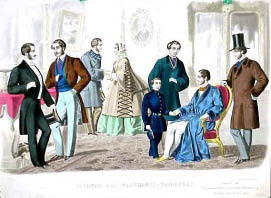
i9, i10 and i11. Late 1850s fashion plates from magazines, such as
Godey's
and the
Gazette
, showing the fashions Victorians wore during the period in which Dickens wrote
A Tale of Two Cities
.
